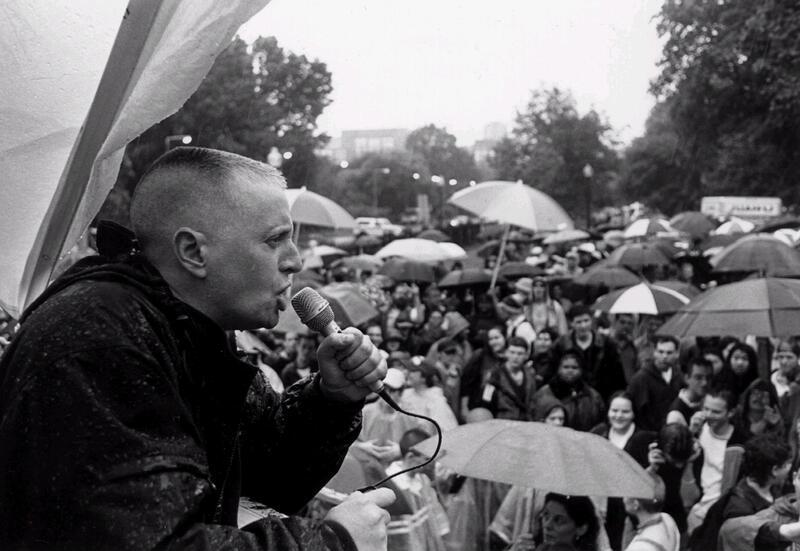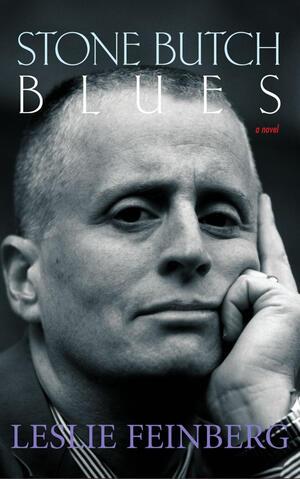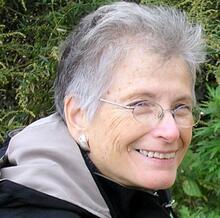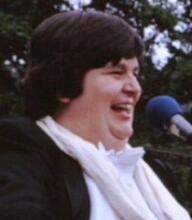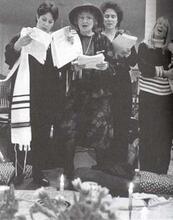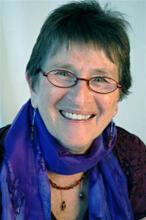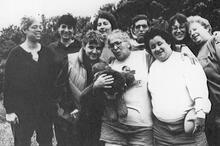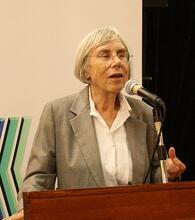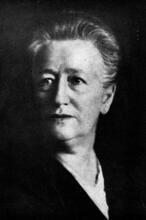Leslie Feinberg
Born in Buffalo, NY, Leslie Feinberg lived much of her life in New York City. While at the forefront of intersectional theory and coalition building, Feinberg became best known for her experience and politics in transgender liberation. She also consistently integrated political analysis of her own multiple identities with her consistent presence and leadership in justice movements, Feinberg was an author of both fiction and non-fiction books, including her most well-known work, Stone Butch Blues. She was an activist, organizer, and gifted speaker.
Biography
Born in Missouri in 1947, directly following the Nazi Holocaust, and raised in working-class Buffalo during the late 1950s and 1960s, Leslie Feinberg was a gifted activist, organizer, speaker, and writer. She is most often remembered in lesbian feminist contexts for her thoughtful exploration of transgender identity. Feinberg described herself as an “anti-racist white, working-class, secular Jewish, transgender, lesbian, female, revolutionary communist” (https://www.lesliefeinberg.net/self/) and remained committed throughout her life to fighting political oppression and societal ignorance in many co-constructed forms.
Leslie Feinberg began working at the age of fourteen in a department store. She did earn a high school degree, despite dropping out of high school. For most of her years as a youth and young adult, Feinberg worked in a series of temporary and low-wage jobs, including dish washer, cleaner on cargo ships, ASL interpreter, data entry, and factory work.
Feinberg first began making the circuit of gay bars in Buffalo, and in her twenties in the late 1960s, she joined the World Workers Party (WWP), becoming a seasoned activist and organizer. As a member of the Workers World Party, she also came to serve as the editor of the political prisoners page of the Workers World newspaper, a position she held for fifteen years. In 1995 Feinberg became the managing editor at the paper.
After publishing two pamphlets (1980 and 1992), Feinberg gained widespread recognition in 1993 with her Stone Butch Blues, a semi-autobiographical work of fiction about a Jewish transgender person growing up in working-class Buffalo in the 1960s. This work won both the Lambda Literary Award and the 1994 American Library Association Gay & Lesbian Book Award. Feinberg authored another work of fiction, Drag King Dreams (2006), in addition to two non-fiction works, Trans–Liberation: Beyond Pink and Blue (1998) and Transgender Warriors: Making History (1996). Feinberg also published a collection of twenty-five journalistic articles, Rainbow Solidarity in Defense of Cuba (2009), as well as a series of articles (1995-2010) called “Lavender and Red” exploring LGBTQ history for the WWP.
Feinberg spent years participating in and leading many pro-labor, anti-anti-Semitic, anti-racist, and anti-war rallies and actions in the late 1960s and early 1970s. In these, she grew her talents, analysis, and leadership skills. Feinberg demonstrated nuanced sensitives that brought people into her sphere. In spite of the intense bigotry she faced, she was a leader from an early age.
Feinberg was awarded an honorary doctorate from Starr King School for the Ministry for her transgender and social justice work. In June 2019, after her death, Feinberg was among the inaugural 50 American “pioneers, trailblazers, and heroes” inducted on the National LGBTQ Wall of Honor within the Stonewall National Monument (the first U.S. national monument dedicated to LGBTQ rights and history) in New York City’s Stonewall Inn.
Feinberg’s life partner was Minnie Bruce Pratt, a professor at Syracuse University in Syracuse, New York. Pratt is an activist and an award-winning writer on subjects of race, class, gender and sexuality. The couple formally married in both New York and Massachusetts in 2011.
Pronoun Choice
For a while in the early 2000s, the politics of pronoun choice became contentious. However, Feinberg was quite clear about her preferences. Feinberg’s thoughtful answer illustrates her awareness of numerous complex issues:
“For me, pronouns are always placed within context. I am female-bodied, I am a butch lesbian, a transgender lesbian – referring to me as ‘she/her’ is appropriate, particularly in a non-trans setting in which referring to me as ‘he’ would appear to resolve the social contradiction between my birth sex and my gender expression and render my transgender expression invisible. I like the gender neutral pronoun ‘ze/hir’ because it makes it impossible to hold on to gender/sex/sexuality assumptions about a person you’re about to meet or you’ve just met. And in an all trans setting, referring to me as ‘he/him’ honors my gender expression in the same way that referring to my sister drag queens as ‘she/her’ does.” (Jaime Tyroler for Transmissions 2006)
Lesbian Feminism
Feinberg emerged as an anti-racist lesbian feminist revolutionary communist. From her early days, her thinking and activism included anti-patriarchy. Living outside major urban centers such as New York City or San Francisco, however, she did not move into this path among others evolving as Jewish feminists. She engaged in lesbian feminist activism with other Jews as she widened her circles and moved geographically in the 1970s and 1980s.
Seeking empowerment, Jewish women and gender benders increasingly organized as feminists, within both Jewish circles and the wider sexist culture. The Jewish and lesbian feminist movements in the United States came into their own by the early 1980s as part of the larger feminist and lesbian feminist movements. By the time Feinberg published her first book in 1993, Jewish and lesbian feminist activism and writing had reached a level of coherence into which Feinberg’s work was immediately embraced on a national level. Feinberg’s 1993 Jewish lesbian feminist anti-racist, working-class heroine fit right into the burgeoning diverse, multi-issue milieu, even as the novel set a new course by centering transgender experience and issues.
Many Jewish lesbians also created a self-conscious political and cultural identity as Jewish lesbian feminists. Like Feinberg, Jewish feminists broadly speaking and Jewish lesbian feminists in particular often did not engage politically as Jewish, certainly not at the start of their careers as activists. As Jewish feminism and Jewish lesbian feminism grew, there was more space for a range of self-identified Jewish feminists and lesbian feminists, in Feinberg’s world and more broadly. We can see this shift in Feinberg’s own work. In her 1993 Stone Butch Blues, the protagonist Jess Goldberg is clearly Jewish, but a Jewish context and ties are largely absent in the narrative. In her 2006 Drag King Dreams, Feinberg’s central character, Max Rabinowitz, is more reflective on her Jewishness, has various Jewishly related engagements and regularly relies on a Jewish friend. (While central to Max’s life, however, this Jewish friend remains separate from the tight cluster of not explicitly Jewish friends with whom Max works and makes politics.)
(Shifting) Whiteness, and Anti-Racism
Feinberg was part of the majority of Jews in the United States by her time who were of European heritage and are today usually identified in United States taxonomies as white. In the context of Feinberg’s life and politics, we can see that race in the United States is not a static assignation. Her access to white privilege changed over her lifetime. Moving from identity to her justice politics, like many Jews in the United States, Feinberg set anti-racism at the center of her work in the world.
Until the mid-20th century, even European-heritage Jews (generally with comparatively lighter skin than Jews from other regions) were outside of the classifications of whiteness as they emerged in United States typologies. When Feinberg was born, just after the Nazi Holocaust, European-heritage Jews in the United States were undergoing a kind of racial reassignment from non-white to potential honorary whites. Seeking to distance the United States from the recently squelched Nazi threat, dominant United States Christian whites moved anti-Semitism more underground. This post-Holocaust collective re-assignment depended on attempts to decimate Jewish difference, in large part through the McCarthy period. Jews were targeted disproportionately during the Red Scare. Feinberg’s experiences reflect the ways that gender, culture, class and discrimination based on these identity groupings are co-constructed. In the midst of this racial re-assignment, as a non-gender normative Jew, Feinberg brought a threatening attention to her working-class family, with its economically precarious situation already at risk during the Red Scare. A gender non-conforming child was a magnet for others’ invasive interest in an historical moment emphasizing conformity.
By adulthood, living in urban northeastern areas of the United States, Feinberg more consistently benefited from white privilege as a European-heritage Jew. As Feinberg’s family experience demonstrates, this new privileged status was not simple and guaranteed. Historically, whiteness in the United States has been understood in a Christian context. Protecting Christian hegemony, this recent racial reassignment remains dependent on assimilation to Christian, white, middle-class norms, including mutually constitutive aspects such as heterosexuality, political affiliation, and gender normativity. This new status and privilege are easily withheld when Jews defy normative expectations. Like Feinberg, while many European heritage Jews are active in anti-racism work and take responsibility for their general experience of white privilege, they also often require adjectives for their whiteness (thus Feinberg’s use of the self-identifier “anti-racist white”). In explicitly identifying as white, Feinberg held herself accountable for white privilege. Her use of an adjective for her identity as white is an explicitly political move. Self-identifying as Jewish puts her whiteness into a specific historical and political context within United States white Christian supremacy.
Class, and Labor Activism
Placing Feinberg squarely in a Jewish context demonstrates the need for new narratives about the co-construction of race and class, white supremacy and investment in capitalism. Karen Brodkin identifies the mid- to late twentieth-century racial-reassignment of numerous United States Jews from non-white to honorary white as bound with a class transformation. Many Jews at this time were moving from the poor and working class to the middle class. However, United States Jews do not fall into expected categories of ethnic groups who may change their racial and socio-economic status and also become more politically conservative. Even with these demographic shifts, Jews continued their work as labor organizers and participated in the Civil Rights and anti-racist movements in numbers disproportionate to other non-Black groups. The trajectory of Feinberg’s entry into the Workers World Party in the early 1970s until her death in 2014 remained in line with this Jewish investment in labor, socialist, communist, and anarchist organizing even as many Jews moved into the middle class and simultaneously came to self-identify (as did Feinberg herself) as white.
Trans, Queers, and Gender Outlaws
Feinberg’s work specifically as a lesbian feminist trans activist was central to her multi-coalition labor organizing. Her trans political analysis grew out of her experiences as gender non-conforming. As a theorist as well as an activist, Feinberg helped move queer conceptualizations in the 1990s away from the often medically defined and restraining concept of “transsexual” toward “transgender.” She eschewed being forced to constantly indicate her “sex” on official documents, and this response and the analysis Feinberg developed from it extended to the idea of merely indicating “transgender” in the same way, as a box to check off. For Feinberg, being identified as trans was not as simple as moving from M or F to T, but instead about opening up spaces to enhance the capacity for people to express their own concepts of gender, free of social constraint or approbation as much as possible within any given social context.
Solidarity, Ally, and Multicultural Organizing
Feinberg connected her multi-layered self-identification (working class, white, Jewish, lesbian, trans) with her commitment to working in multicultural coalitions. In fact, Feinberg’s last project (unfinished when she died, but now being completed by friends) was developing a 20th-anniversary edition of her first novel Stone Butch Blues. Feinberg sought to create a free access edition of the book with a slideshow, “This Is What Solidarity Looks Like,” “documenting the breadth of the organizing campaign to free CeCe McDonald, a young Minneapolis (trans)woman organizer and activist sent to prison for defending herself against a white neo-Nazi attacker” (Pratt 2014).
Selected Works by Leslie Feinberg
Transgender Liberation: A Movement Whose Time Has Come. New York, NY: World View Forum, 1992.
Stone Butch Blues: A Novel. San Francisco, CA: Firebrand Books, 1993.
Transgender Warriors: Making History from Joan of Arc to Dennis Rodman. Boston, MA: Beacon Press, 1996.
Trans Liberation: Beyond Pink or Blue. Boston, MA: Beacon Press, 1998.
“Lavender & Red.” Workers’ World, June 8, 2005. Retrieved November 26, 2017, from https://www.workers.org/lavender-red/.
Drag King Dreams. New York, NY: Carroll & Graf, 2006.
Rainbow Solidarity in Defense of Cuba. New York, NY: World View Forum, 2009.
Brodkin, Karen. How Jews Became White Folks and What that Says About Race in America. New Brunswick, NJ: Rutgers University Press, 1998.
Cohler, D. “Afterword: Drag King Dreams Deferred.” In Citizen, Invert, Queer: Lesbianism and War in Early Twentieth-Century Britain, 197-209. Minneapolis, MN: University of Minnesota Press, 2010.
Editors, A. “Transgender Pioneer and Stone Butch Blues Author Leslie Feinberg Has Died.” The Advocate, November 17, 2014. Retrieved February 17, 2015, from https://www.advocate.com/arts-entertainment/books/2014/11/17/transgende…;
Feinberg, Diane Leslie. Journal of a Transsexual. New York: World View Publishers, 1980.
Hogan, M. I. “’Still me on the inside, trapped’: Embodied Captivity and Ethical Narrative in Leslie Feinberg's Stone Butch Blues.” Third Space: A Journal of Feminist Theory and Culture, 3(2): 2004.
Pratt, M. B. “Transgender Pioneer Leslie Feinberg of Stone Butch Blues Has Died.” The Advocate, November 17, 2014. Retrieved March 17, 2018, from https://www.advocate.com/arts-entertainment/books/2014/11/17/transgende….
Prosser, J. “No Place Like Home: The Transgendered Narrative of Leslie Feinberg's Stone Butch Blues.: Modern Fiction Studies, 41(3-4), fall-winter 1995: 483-514.
Stafford, A. “Departing Shame: Feinberg and Queer/Transgender Counter-cultural Remembering.: Journal of Gender Studies, 21(3) 2012: 301-312.
Tyroler, J. “Interview with Leslie Feinberg.” Camp Kansas City, July 28, 2006. Retrieved April 30, 2015, from http://www.campkc.com/campkc-content.php?Page_ID=225

